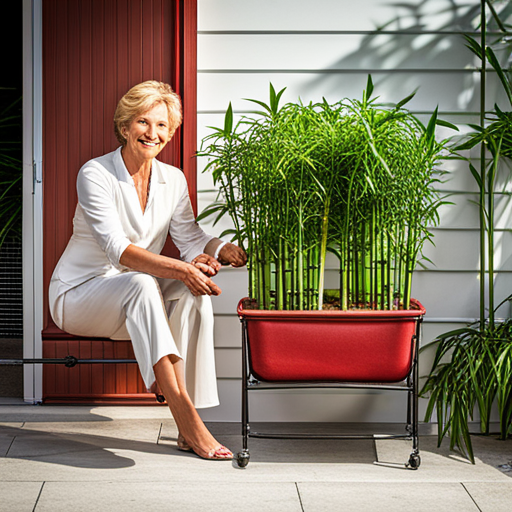Choosing Hardy Bamboo for Zone 5: Climate, Containment, and Care
Bamboo is a versatile and resilient plant that can thrive in a variety of climates, including Zone 5. Selecting the right bamboo species for this zone requires careful consideration of factors such as climate, containment, and care.
In Zone 5, both clumping and running bamboo species can be successfully grown. Clumping varieties such as Fargesia rufa and Fargesia Denudata are non-invasive and well-suited for this zone. Running bamboos like Phyllostachys bissetii and Phyllostachys aureosulcata ‘Spectabilis’ can also flourish with proper care.
When planting bamboo, spacing is crucial for creating a dense screen, and soil amendment is recommended for optimal growth. It is advisable to plant bamboo between February and May, and regular fertilization and generous watering are essential for its well-being.
For running bamboos, managing their growth with root barriers or trench digging is necessary. Container bamboos, on the other hand, require extra protection during winter and are generally less hardy than those planted in the ground.
By considering these factors, one can successfully choose and cultivate hardy bamboo in Zone 5.
Contents
- 1 Our Highlighted Points
- 2 Zone 5 Bamboo Species
- 3 Planting and Maintenance Tips
- 4 Container Bamboo Care
- 5 What Are the Best Hardy Bamboo Options for Zone 5 Gardens?
- 6 Frequently Asked Questions
- 6.1 What are some common pests and diseases that affect bamboo in Zone 5?
- 6.2 Can bamboo be grown in partial shade in Zone 5?
- 6.3 Are there any specific pruning techniques or tips for maintaining bamboo in Zone 5?
- 6.4 What are some common signs of overwatering bamboo in Zone 5?
- 6.5 Are there any specific considerations for growing bamboo in Zone 5 if you have children or pets?
Our Highlighted Points
- Clumping varieties like Fargesia rufa and Fargesia Denudata are non-invasive and well-suited for Zone 5.
- Running bamboos like Phyllostachys bissetii and Phyllostachys aureosulcata ‘Spectabilis’ can also flourish with proper care.
- Proper spacing and soil amendment are important for optimal growth and creating a dense screen.
– Container bamboos require extra protection during winter and careful monitoring of watering to thrive in Zone 5.
Zone 5 Bamboo Species

The selection of bamboo species suitable for Zone 5 should consider both clumping non-invasive species, such as Fargesia rufa and Fargesia Denudata, as well as running species like Phyllostachys bissetii, Phyllostachys aureosulcata ‘Spectabilis’, Phyllostachys atrovaginata, Arundinaria gigantea ‘Macon – Rivercane bamboo’, Phyllostachys rubromarginata, and Phyllostachys nuda, taking into account their growth habits and containment requirements.
Running bamboos, such as Phyllostachys species, spread vigorously by sending out underground rhizomes, while clumping bamboos, such as Fargesia species, form dense clumps and spread slowly.
For those looking to create a privacy screen, running bamboos are often preferred due to their faster growth rate and ability to form a dense barrier. However, they require containment measures such as root barriers or trench digging to prevent them from spreading uncontrollably.
Clumping bamboos, on the other hand, are easier to manage as they only spread a few inches a year and can be controlled through root pruning.
Planting and Maintenance Tips

Planting and maintenance of bamboo in Zone 5 involves appropriate spacing, timely planting, soil amendment, regular fertilization, and careful watering to establish healthy growth. To ensure successful bamboo growth, it is important to consider soil amendment benefits. Adding organic matter such as compost or well-rotted manure can improve soil fertility, drainage, and water-holding capacity. This promotes root development and overall plant health. Additionally, regular and generous watering is crucial, especially during the establishment phase. Newly planted bamboo requires frequent watering until it becomes established, but overwatering should be avoided as it may lead to root rot. To help maintain moisture levels, applying a layer of mulch around the base of bamboo plants can help conserve water and suppress weed growth. Overall, proper planting techniques and regular maintenance practices are essential for the successful growth and health of bamboo in Zone 5.
| Soil Amendment Benefits | Watering Requirements |
|---|---|
| Improves soil fertility | Regular and generous watering |
| Enhances drainage | Avoid overwatering |
| Increases water-holding capacity | Mulching to conserve moisture |
Container Bamboo Care

Container bamboo requires specific care and attention to ensure optimal growth and health. When growing bamboo in containers in USDA Zone 5, it is important to provide proper winter protection.
Container bamboos are generally less hardy than those planted in the ground, so they are more susceptible to cold temperatures and frost damage. To protect container bamboos during winter, it is recommended to move them to a sheltered location, such as a garage or shed, or wrap the containers with insulating material.
Additionally, container bamboos are more sensitive to environmental stress, such as extreme temperatures and fluctuations in moisture levels. Therefore, it is crucial to monitor and adjust watering accordingly, avoiding overwatering or allowing the soil to dry out completely.
By providing appropriate winter protection and minimizing environmental stress, container bamboo in Zone 5 can thrive and add beauty to any outdoor space.
Also, make sure to protect your lucky bamboo from mosquito breeding.
What Are the Best Hardy Bamboo Options for Zone 5 Gardens?
When it comes to finding the best hardy bamboo for zone 5 gardens, there are a few excellent options to consider. One such option is the hardy bamboo for zone 4 gardens. With its ability to withstand colder temperatures and thrive in harsh conditions, this bamboo variety is a great choice for zone 5 gardeners looking for resilient and attractive plants.
Frequently Asked Questions
What are some common pests and diseases that affect bamboo in Zone 5?
Common pests and diseases of bamboo in zone 5 include bamboo mites, bamboo aphids, bamboo mealybugs, bamboo rust, and bamboo yellowing disease. Identification and control methods vary, including insecticidal soaps, neem oil, and pruning infected parts. The best bamboo varieties for zone 5 are those with cold hardiness and suitable growth habits.
Can bamboo be grown in partial shade in Zone 5?
Growing bamboo in partial shade in Zone 5 has both pros and cons. While bamboo can tolerate some shade, it may not grow as vigorously or reach its full potential. The best bamboo varieties for partial shade in Zone 5 include Fargesia rufa and Fargesia Denudata.
Are there any specific pruning techniques or tips for maintaining bamboo in Zone 5?
Pruning techniques for maintaining bamboo in Zone 5 include regular removal of dead or damaged culms, thinning out overcrowded areas, and controlling height by cutting culms at desired heights. Containment methods involve using root barriers or trench digging to prevent spreading.
What are some common signs of overwatering bamboo in Zone 5?
Common signs of overwatering bamboo in zone 5 include yellowing or wilting leaves, root rot, and stunted growth. To prevent overwatering, ensure proper drainage, water deeply but infrequently, and avoid watering during rainy periods or when the soil is already moist.
Are there any specific considerations for growing bamboo in Zone 5 if you have children or pets?
Safety and considerations when growing bamboo with children and pets in Zone 5 involve selecting non-toxic bamboo species, ensuring proper containment to prevent access to the plants, and educating children about the potential hazards. Best practices for bamboo containment include using root barriers or trench digging for running bamboo, and regular root pruning for clumping bamboo.

